
Just a heads up, if you buy something through our links, we may get a small share of the sale. It’s one of the ways we keep the lights on here. Click here for more.
Computer technology can be Greek to some but others can speak it fluently without issue. However, a quick dive into the specifications can help clarify the matter, enabling you to make your tech-related decisions easier and more informed.
Undeniably, computers of all kinds including minicomputers are in high demand, specifically, as people take to a digital nomad lifestyle and remote work. For example, Statista reveals that 122.1 million tablets are expected to be shipped globally by 2023. And those are just numbers showing tablets, a small arm of the entire tech ecosystem.
In this context, let’s talk about another subset of the computer family, mini computers. Here’s a dive into everything that you need to know about Nano-ITX computer:
What is a Nano-ITX computer?
Nano ITX is a computer motherboard. It was first proposed by VIA Technologies in March 2003 and ended up seeing the light of the day in late 2005. Its measurements are 12 × 12 cm or 4.7 × 4.7 inches.
Some of the prominent features that Nano-ITX computers showcase are:
- They are fully integrated
- Low power consumption with several uses
- Useful for smart digital entertainment devices like media centers, car PCs, set-top boxes, and thin devices to name a few
Essentially, there are four types of Nano-ITX motherboard product lines. These are VIA’s EPIA N, VIA EPIA NR, EPIA NL, and the EPIA NX. You can get these boards from several manufacturers supporting different CPU platforms.
Mini-ITX is different than micro-ATX
Both micro-ATX and mini-ITX are small form factor motherboards, which are commonly used within electronics. You can easily find them in digital cable boxes, handheld media players, home theater systems, and more.
Both these small motherboard types are credited for their ease of management and assembling. These are also affordable, which is a sweet cherry on top of their other features.
Mini-ITX highlights feature such as low noise, small size, and easy power maintenance. Therefore, such a motherboard is commonly used in small spaces like network devices. In contrast, however, the micro-ATX is much older than Nano-ITX with the former originating in 1997 and the latter appearing in 2003.
Micro-ATX is also much bigger in size as compared to nano-ITX. Moreover, it is up for grabs in three different sizes.
You need a separate keyboard and other gadgets when getting a Nano-ITX computer
When you buy a nano-ITX computer, you are basically getting a mini PC. So, you are only getting a monitor. You will have to add a keyboard, mouse, speakers, and monitors yourself. You can always reuse your old keyboard, monitor, speakers, and mouse provided they are compatible with your mini-PC.
Possible upgrades and memory support
The number of upgrades in a Nano-ITX PC is extremely limited. This is due to its small size, which means that the motherboard doesn’t have multiple slots for different parts. There also isn’t any physical room to fit different parts.
Hence, if you buy a mini PC and plan to update it with a Core i7 CPU later, then you should know that that wouldn’t be possible as Nano-ITX doesn’t afford upgrades. It is also due to its size that a mini PC support laptop RAM only. Laptop RAM is much smaller than desktop RAM. Therefore, a Nano-ITX computer can support one but not the other.
Support for hard drives
Mini PCs also support specific hard drives, mainly two sizes: M.2 and 2.5 inches. The former offers only flash storage, whereas, the latter format offers flexibility between the traditional HDD and SSD.
To elaborate, M.2 is the latest version of mSATA. It is a bit narrower and longer than a typical SSD and somewhat faster than a standard SSD. On the other hand, a 2.5-inch SSD works at a faster pace than a 2.5-inch HDD, but it does not offer as much storage capacity as an HDD. So, your choice should be easy. Pick SSD when speed matter to you more than capacity and go for HDD when storage is your priority instead of speed.
Use for mini PCs
Nano-ITX is a great pick for the non-demanding user, for instance, when you have to do basic web browsing and productivity tasks. It is not a suitable choice for gamers though. A mini PC with a nano-ITX board cannot hold a lot of power.
If you need to do more than simple web browsing, then you will need to get a Pentium M Mini-ITX motherboard.
Concluding thoughts
To summarize, Nano-ITX computers are designed for reliable performance and rich functionality in a compact size. These motherboards offer extensive flexibility for applications in which power efficiency and compact size are required such as POS, lottery machines, and kiosks to name a few.
What’s more, Nano-ITX allows developers to customize their designs in fully-configured embedded devices. While investing in such technology though, it is best to consider other factors like associated RAM, speed, space, and so on.
Are you using a Nano-ITX computer for anything in your home? Plan to? Let us know down below in the comments or carry the discussion over to our Twitter or Facebook.
Editors’ Recommendations:
- Microsoft’s rumored Surface Buds may be a thing for Apple haters to put in their ears
- A lapse in Microsoft’s security allowed hackers to read your Hotmail, Outlook, and MSN emails
- Twitch gets into the video game business with its own karaoke title
- Juul addresses underage users with a new pilot program in Houston
- If you’re a Verizon FiOS customer, update your router asap






























